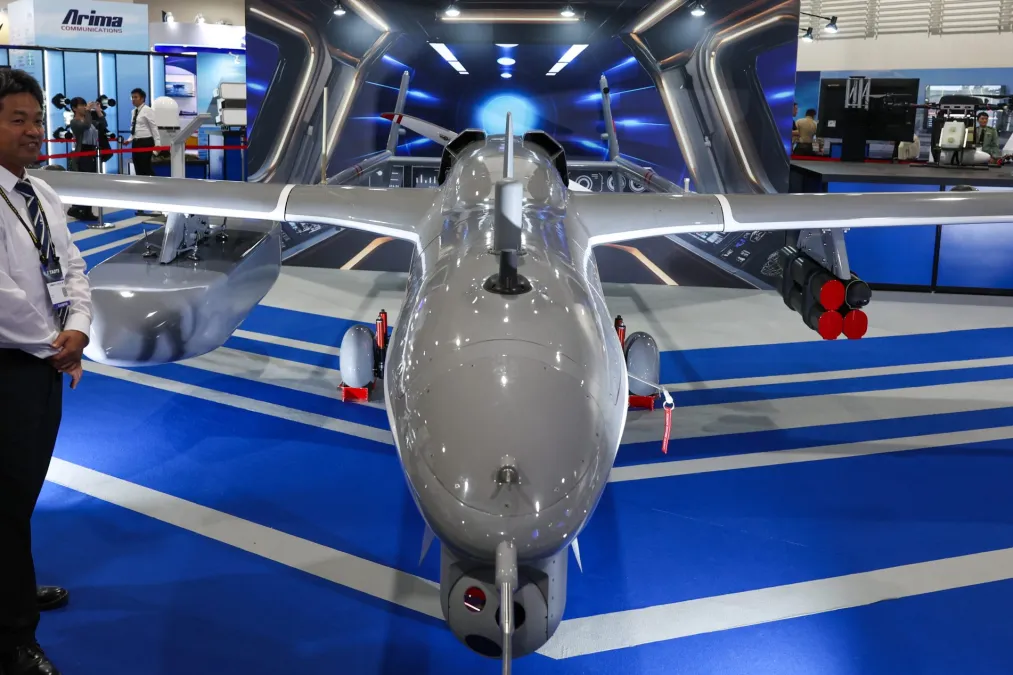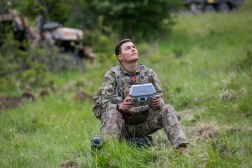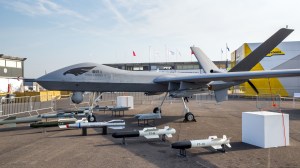Taiwan moves to counter China’s drone dominance

Taiwan is strategically moving to expand its arsenal of military and commercial drones, as China mobilizes and modernizes its forces with aims to be ready to seize its smaller, self-governing neighbor as early as 2027.
During a panel hosted by the Center for a New American Security on Tuesday, defense experts discussed Taiwan’s unfolding plans to grow its domestic production pipelines for unmanned aerial systems and its military’s adoption of associated, emerging weapons technologies. They also shed light on ways recent U.S. initiatives, as well as the Russia-Ukraine war, are informing those pursuits.
“China now has the dominance of the supply on a lot of different components that are used in drones,” said Hong-Lun Tiunn, a nonresident fellow at the Research Institute for Democracy, Society and Emerging Technology.
“So that is very critical for Taiwan, for us to actually start gradually building up a non-reliant supply chain [and] to basically make sure that — way before the contingency happens — we already have the capacities to manufacture enough and good quality components and drone models that can be integrated into our layered defense strategy,” Tiunn noted.
Although the Chinese government sees the island as a piece of its territory, Taiwan has been self-ruled for more than 75 years.
Tensions between Beijing and Taipei have intensified in the last decade, and particularly since Chinese President Xi Jinping unveiled his intent to ensure that the People’s Liberation Army would be prepared and equipped to “unify” or invade its smaller neighbor by 2027.
“The folks who study this closely say, ‘Look, that’s a modernization goal. It’s not a go-by date.’ And our best understanding is still that Xi Jinping and the Chinese leadership’s calculus around this is conditions-based and that they have been aiming toward a short, sharp, low-cost invasion at acceptable cost,” said Ely Ratner, former U.S. assistant secretary of defense for Indo-Pacific security affairs and current principal at Marathon Initiative. “And until they feel like they can achieve that, they’re going to hold off.”
Beijing is also involved in territorial disputes with other nearby countries, including some American allies.
And while the U.S. is a top arms provider for Taiwan, some observers have raised concerns that Taipei isn’t optimizing its weapons purchases enough considering the possibility for a future conflict.
At the CNAS panel, experts discussed how China’s military buildup and refresh efforts have been, “if not singularly, very focused on” this potential invasion scenario. The nation has been rapidly developing a portfolio of relevant assets, including but not limited to space and cyber systems, long-range strike capabilities and a variety of maritime and aerial drones.
“China has invested very heavily in uncrewed systems of all types, and is also watching what’s going on in Ukraine,” said Stacie Pettyjohn, senior fellow and director of CNAS’ Defense Program. “I would imagine uncrewed surface vehicles, drone boats and underwater vehicles playing a larger role, as well as drones with sensors and capabilities to attack ships. The distances are huge, and that is really disadvantageous for the U.S. The U.S. needs drones of a different class than what we’ve typically seen in Ukraine. Taiwan can take advantage of shorter-range drones like the Ukrainians have, and use them quite effectively.”
Pettyjohn, who previously served in the Joint Staff’s strategy, plans and policy office and other Pentagon-supporting roles, also said she expects more electronic warfare and satellite communications jamming if there’s a conflict between China and Taiwan.
“So, I think that Taiwan’s best strategy is to rely more on autonomy, on drones,” Pettyjohn said.
The Research Institute for Democracy, Society and Emerging Technology (DSET) is a national think tank that Taiwan’s government set up in 2023. There, Tiunn — an alumnus of the U.S. Department of State’s International Visitor Leadership Program, who also previously served as chief policy aide in the office of a Taiwanese legislator — leads strategic projects on Taiwan-U.S. drone co-production and other international security topics.
He pointed to Taiwan’s ambitious new goal to produce 180,000 drones per year by 2028.
“That is not enough, at all, from the lessons that we learn from Ukraine, but that is the short-term goal that’s set by the Taiwanese government. And … roughly 10,000 units per year — right now, that is our current capacity, based on the 2024 estimations,” Tiunn said.
He outlined Taipei’s path ahead to meet its targets.
“It’s really important to acknowledge that [a war between China and Taiwan] will not end within several days. So after the initial several days, when we have the first few waves of attack and defense, the way that Taiwan defends itself will change — because that is matter on how many munitions we have, how many spare parts we have, how [much] capacity we [have left or can] continue repair, continue manufacturing those spare parts for our drones,” Tiunn noted. “So, that is why Taiwan’s government is starting to think about how [we can] make sure everything is self-sufficient, and that we can make it locally to make sure that Taiwan can continue to fight our own fight.”
He and other panelists also discussed the Pentagon’s Replicator initiative, which was launched during the Biden administration.
Replicator was initially billed as an accelerated technology and procurement modernization campaign designed to counter China’s massive military buildup in the Indo-Pacific, by incentivizing U.S. production capacity and the services’ fielding of drones en masse — through replicable processes — at a faster pace than before.
Details about the current status, total cost to-date, and overarching progress of the Replicator program have been sparse since the Trump administration assumed leadership this year.
In response to questions during Tuesday’s panel, Tiunn confirmed that Taiwan’s “drone development policies [were] inspired by Replicator, a lot.”
“So, we actually try to move faster in the acquisitions process, to make sure that those newer-generation drones can be used by our military, no matter for combat purposes, operational purposes or the training purposes,” he said.






